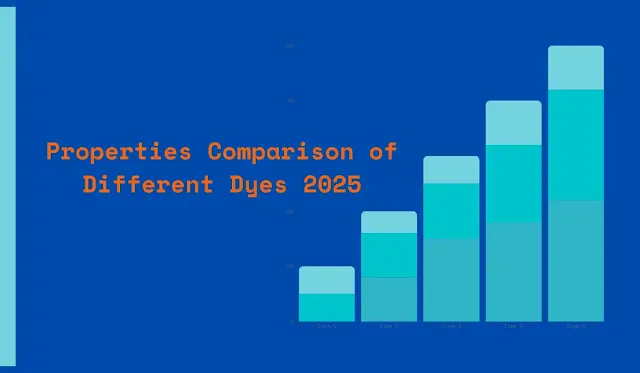Properties Comparison of Different Dyes 2025
Dyeing is an essential process in various industries, from fashion to manufacturing, where colors and their vibrancy are crucial. As we step into 2025, new innovations in dye technology are transforming the market.
In this blog, we'll explore the properties of different dyes in 2025, helping you make informed decisions for your dyeing processes.
What Are Dyes?
Before diving into the comparison, it's important to understand what dyes are and their basic function. Dyes are substances used to impart color to materials, such as fabrics, leathers, plastics, and more. They interact chemically or physically with the material to produce lasting colors. Different types of dyes are used depending on the material and desired effect.
Types of Dyes in 2025
1. Reactive Dyes
- Properties: Reactive dyes form a covalent bond with the fabric fibers, ensuring a vibrant and long-lasting color. They are widely used for dyeing cotton and other cellulosic fibers.
- Advantages: High color fastness, easy application, and environmentally friendly alternatives available in 2025.
- Disadvantages: Requires a controlled dyeing process and has high water usage.
2. Acid Dyes
- Properties: Acid dyes are primarily used for dyeing protein fibers like wool, silk, and nylon. They offer brilliant color but are sensitive to pH levels.
- Advantages: Produces a wide range of bright, vibrant colors. Stable under acidic conditions.
- Disadvantages: Lower fastness on fibers and may require special care.
3. Direct Dyes
- Properties: Direct dyes can be applied directly to fabric without needing a mordant. They are often used for cellulosic fibers like cotton.
- Advantages: Simple application process, low cost, and suitable for home dyeing.
- Disadvantages: Poor light and wash fastness, meaning the colors can fade quickly.
4. Disperse Dyes
- Properties: Disperse dyes are non-ionic dyes used mainly for dyeing synthetic fibers, especially polyester.
- Advantages: High light fastness and resistance to washing.
- Disadvantages: Requires high temperatures for dyeing, which may not be energy efficient.
5. Vat Dyes
- Properties: Vat dyes are water-insoluble dyes, traditionally used for dyeing cotton. These dyes require a reduction process before being applied to the fabric.
- Advantages: Superior fastness to light, washing, and rubbing.
- Disadvantages: Complex application process and higher cost.
Dyeing Innovations in 2025
The dyeing industry has been evolving rapidly with an emphasis on sustainability and eco-friendly practices. In 2025, manufacturers are focusing on reducing water usage, utilizing bio-based dyes, and minimizing chemical waste. Let's take a look at some innovations:
- Eco-friendly Reactive Dyes: Reduced water consumption and less energy-intensive processes.
- Bio-based Vat Dyes: Developed from renewable sources, reducing the carbon footprint of the textile industry.
- Low-energy Disperse Dyes: New formulations allow dyeing at lower temperatures, conserving energy.
How to Choose the Right Dye in 2025?
When selecting a dye, it's important to consider the material you're working with, the desired color fastness, and the environmental impact of the dyeing process. Below are a few factors to guide your decision:
- Fiber Type: Reactive dyes for cotton, acid dyes for silk and wool, disperse dyes for polyester.
- Color Fastness: If long-lasting colors are critical, vat dyes or reactive dyes are often the best choice.
- Environmental Considerations: Look for dyes that use less water and sustainable sources, especially if you're aiming for an eco-conscious production process.
Conclusion
As we look ahead to 2025, the dye industry continues to innovate, bringing more sustainable and efficient options to the market. Whether you're a textile manufacturer or a DIY dye enthusiast, understanding the properties of different dyes is crucial for achieving the best results. By choosing the right dye for your material and considering environmental impacts, you can ensure vibrant, durable, and eco-friendly colors for your projects.
Stay tuned for more updates as the industry evolves, and remember to prioritize sustainable choices in your dyeing process.




.png)
.png)



